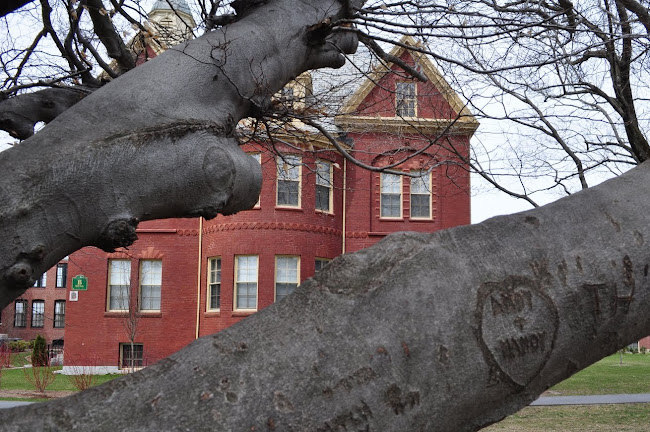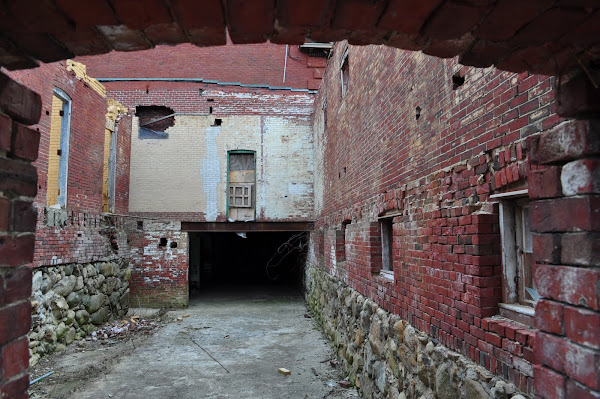The predecessor of the Foxborough State Hospital, the Massachusetts Hospital for Dipsomaniacs and Inebriates was established in 1889 to retreat and cure alcoholics. Did the society regard those who succumbed to alcoholism as the casualty, sinner, lunatic or criminal? That was the first question when I saw this antiquated hospital name.
Located 20 mile (32km) south of Boston, the town of Foxborough now hosts the stadium for the New England Patriots. Driving through cranberry bogs looked like blood pools, the marshlands reminded me that it was getting close to the infamous Bridgewater Triangle.
After 1905, the Massachusetts Hospital for Dipsomaniacs and Inebriates went through a gradual transition to a psychiatric institution. By 1914, all the alcoholic patients were transferred to the Pondville State Hospital (aka the Norfolk State Hospital), some 50 mile southeast of Foxborough. And the inebriate hospital in Foxborough became the Foxborough State Hospital.
After less than 10 years of operation as a hospital specialized in alcoholism (and drug addiction), the Pondville was under the influence of history. The aftermath of World War I had affected American society; the federal government took over the hospital in 1918 to treat soldiers with PTSD related mental problems.
The Massachusetts Hospital for Dipsomaniacs and Inebriates was constituted with a few isolated wards. After the transition to the Foxborough State Hospital, the building blocks were connected by hallways functioned as day rooms. In addition, numerous isolated buildings and facilities such as coal generated power plant, laundry, staff housing, sewage treatment plant, and TB sanatorium dotted the campus.
When did Andy and Mandy inscribe their love to a tree trunk?
In 1976, the Foxborough closed its door. After the hospital functioned as various government related facilities and an annual Halloween horror house, it was finally converted to a condo in 2009.
It was an early spring, but the turf on the condo property was bright green, signifying the comfortable and aesthetically pleasing American ideal. Well, this is the nice side of the former hospital; the backside is a barren, bleak space that its future could well be in oblivion in few years time.
Now I ask you the question I had in the beginning: did the society in the early 20th century regard those who succumbed to alcoholism as the casualty, sinner, lunatic or criminal? Why did the state establish a hospital specialized in alcoholism?
The purpose of such hospitals as the Pondville State Hospital was "to provide hospital treatment for 'hopeful' cases and a detention colony for noncriminal but chronic cases." (from Asylum Projects) I hope the former function was the main focus of such institutions, but as with the case of asylums back then, the main purpose of such institutions was geographically externalizing the certain segment of society from the rest.
Railroads in American society often function dividing one community to the other
But why did the state built such a grandiose redbrick to show the public that this would be the end result if you succumb to intoxication? Sure, so many families have been destroyed by family members' drinking problem, and many have lost their lives from poising themselves; I really hate to see that.
First thought I came up with was the rise of the prohibition movement in the mid 19th century that eventually lead to the enactment of the Volstead Act of 1919. The Prohibition Movement was backed up by some denominations of Protestant churches claimed drinking as the evil leads to immorality and sin. This was the beginning of the Roaring Twenties.
But there is more systematic, calculative rationalistic tone under the redbrick. I remembered the tragic stories of unwed mothers in the 20's confined into asylums in England, labeled as a societal threat that weakens the nation's strength with their "deviant" genes (please refer to my post: Our Lady's Hospital, Cork, Ireland.)
What were deemed as "deviant genes"? Eugenics was the scientific, rational answer to the question in the early 20th century. In May, 1911 a special committee was formed under the eugenics section of the American Breeders Association. Consisted with an advisory panel whose expertise in such studies as law, medicine, psychiatry, and social and political sciences, the main purpose of the committee was to identify and sterilize groups of people who would "contaminate" the American population with their "inferior" genes. Two months after the formation of the committee, a series of conferences were held in an exclusive New York club in order to purify the American blood:
Ten groups were eventually identified as "socially unfit" and targeted for "elimination". First, the feebleminded; second, the pauper class; third, the inebriate class or alcoholics; fourth, criminals of all descriptions including petty criminals and those jailed for nonpayment of fines; fifth, epileptics; sixth, the insane; seventh, the constitutionally weak class; eighth, those predisposed to specific diseases; ninth, the deformed; tenth, those with defective sense of organs, that is, the deaf, blind and mute. -- from War Against the Weak by Edwin Black, italicized by S.K.
1911 was the period when the Foxborough was transitioning from an inebriate hospital to a psychiatric hospital, transferring its alcoholic patients to the newly established Pondville State Hospital. The increasing number of asylums indicates the burgeoning idea of Eugenics was taking shape as the redbirck architecture, symbolizing the measure of isolating the "socially unfit" for the sake of eventual "elimination".
You may think "Thank god, such an absurd, cold-heated notion is now gone! No wonder why those asylums are now abandoned." Well, I don't want to say much about, but think about this "Economic Darwinian" society we are in...
How long is this abandoned wheelchair sit on this spot? This isn't a kind of wheelchair that one can play basketball with; this thought made me sad. And how many times would I encounter the notion of Eugenics when I look at those redbricks?
I came across a chapel of which annex roof was totally caved in. It looked like it would be demolished any time soon. Some of the windows were broken and even not boarded. I peeped through one of the openings to see the interior.What was the function of this space?
A young woman with her cell phone, chatting about her everyday life passed behind of me while I was completely absorbed by the sight of the ruin. She probably lives in the condo. The contrast between her everyday life and the surreal sight of the abandoned interior space was begging to provoke some existential questions about the ephemeral nature of people's memory.
Abandoned interior of FSH Chapel
From "Memory" by Serghei Minenok
"Memory" is a five minutes documentary about a movie director, Andrei Tarkovsky's childhood home in Moscow. While it was directed by Serghei Minenok in 1997, the filming style and spatial sense honor Tarkovsky's movies represented by Stalker*.
*Plot summary: a guide called the Stalker brings two clients to the abandoned area called the Zone that is heavily guarded by the government. The objective of their trip to the Zone is reaching "the Room" because the space is rumored to embody the visitor's deepest desire. The Zone is often compared to the area surrounding Chernobyl nuclear powerplant of which disaster took place 7 years after the movie was made.
What striking about the documentary is the stark contrast between the completely ruined Tarkovsky's house and the everyday life of a busy Moscow street where cars constantly pass by. While his house symbolizes a wet, bleak space like the forbidden Zone in Stalker, the outside is an ordinary post-Soviet Moscow.
From "Memory" by Serghei Minenok
FSH Chapel, from Google Map
There is an interesting similarity between the abandoned Chapel and Tarkovsky's home. At the Foxborough, the residents park their car around the ruin and conduct everyday tasks like unloading grocery and chatting on a cell phone. The intense history of the chapel and hospital becomes obscure by everyday life and will be forgotten from our memory, waiting to be swallowed by the surrounding environment like the Tarkovsky's childhood home was destined to be.
Continue to Foxborough State Hospital Cemetery
Locate Foxborough State Hospital @ Google Map
War Against the Weak by Edwin Black
Asylum Projects: Foxboro State Hospital
Asylum Projects: Pondville State Hospital
Opacity: Foxboro State Hospital
Stalker directed by Andrei Tarkovsky (1979)


















Great photos and parallels, Skuko--very moving stuff. The condo's barren back lot is quite a contrast.
ReplyDeleteHi Matthew.
ReplyDeleteThanks for following my wandering thoughts;)
The photographs in this post/blog are quite phenomenal! Would love to see the place in person. The best photograph in this entire set is the one with the abandoned wheelchair with the housing unit in the background! Breathtaking angle/composition!
ReplyDeleteGood work!
-Landis
Hi Landis.
ReplyDeleteThanks for the appraisal. I particularly worked on the angle/composition with the wheelchair photo, so I appreciate your comment!
Dreaming about a new lens...
Does anyone know where I could get original floor plans for the hospital?
ReplyDelete